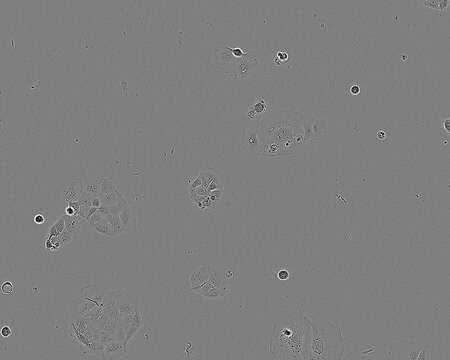Recommended Products
Product Name
F-36P, 99072808
biological source
human bone
growth mode
Suspension
karyotype
43,Y(Xp+,-5,-7,-13,-16,-17,-19,-21,2q-,9p+,10q+,+4mar)
morphology
Lymphoblastoid
products
Not specified
receptors
Not specified
technique(s)
cell culture | mammalian: suitable
relevant disease(s)
cancer
shipped in
dry ice
storage temp.
−196°C
Cell Line Origin
Human leukemia, myelodysplastic syndrome
Cell Line Description
The cell line F-36P has been established from a 65 year old male patient, who was diagnosed with refractory anaemia with excess blasts (RAEB), a subtype of myelodysplastic syndrome (MDS). This non-lymphoid leukemia line was obtained from the patient′s pleural fluid at time of progressed to overt leukemia. F-36P is cytokine-dependent requiring granulocyte-macrophage colony-stimulating factor (GM-CSF) or Interleukin 3 (IL-3). Cells have been shown to synthesize haemoglobin when GM-CSF or IL-3 is substituted by erythropoietin (Epo). They have been reported to be positive for leukocyte common antigen (CD45) and some multilineage markers such as CD13, CD33 and CD34, but are negative for T- and B-cell antigens and mature myelomonocytic antigens. Due to their reaction with some monoclonal antibodies recognising erythroid and platelet glycoproteins it has been suggested that F-36P has a multilineage phenotype.
Application
Study of differentiation and effect of growth signals
DNA Profile
STR-PCR Data: Amelogenin: X,Y
CSF1PO: 9
D13S317: 10
D16S539: 10,12
D5S818: 13
D7S820: 9,11
THO1: 8
TPOX: 9,11
vWA: 14,16
CSF1PO: 9
D13S317: 10
D16S539: 10,12
D5S818: 13
D7S820: 9,11
THO1: 8
TPOX: 9,11
vWA: 14,16
Culture Medium
RPMI 1640 + 2mM Glutamine + 5ng/ml rh IL-3 + 5% Foetal Bovine Serum (FBS).
Subculture Routine
Maintain cultures between 3-9 x 100,000 cells/ml; 5%CO2; 37ºC.
Other Notes
Additional freight & handling charges may be applicable for Asia-Pacific shipments. Please check with your local Customer Service representative for more information.
Choose from one of the most recent versions:
Certificates of Analysis (COA)
Lot/Batch Number
Sorry, we don't have COAs for this product available online at this time.
If you need assistance, please contact Customer Support.
Already Own This Product?
Find documentation for the products that you have recently purchased in the Document Library.
Our team of scientists has experience in all areas of research including Life Science, Material Science, Chemical Synthesis, Chromatography, Analytical and many others.
Contact Technical Service

